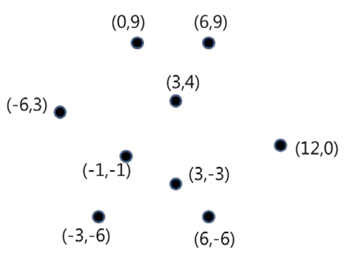
문제
n개의 도시를 가진 나라가 있다. 이 나라에서는 도시들 중 가장 먼 두 도시 사이에 직행 고속도로를 놓으려 한다.
고속도로는 시작점과 끝점이 아닌 다른 나라를 통과해도 된다. 즉, n개의 도시 중 유클리드 거리가 가장 먼 두 도시를 찾으려 한다. 모든 도시는 한 평면 위에 있다.

위의 예제에서는 (12,0)의 도시와 (-6,3)의 도시가 가장 먼 유클리드 거리를 갖는다.
도시 n개의 좌표가 주어지면 모든 두 도시 쌍의 거리 중 가장 먼 두 도시를 찾아라.
입력
첫째 줄에 테스트 케이스의 수 T가 주어진다.
각 테스트 케이스의 첫 줄엔 도시의 개수 n이 주어진다. (2 ≤ n ≤ 200,000) 그 후 n줄에 걸쳐 각 도시의 x좌표와 y좌표가 주어진다. (-10,000,000 ≤ x, y ≤ 10,000,000) x, y는 항상 정수이며, 어떤 두 도시가 같은 점 위에 있는 경우는 없다.
출력
테스트 케이스마다 가장 먼 두 점의 좌표를 출력한다.
만일 그 두 점의 좌표가 각각 (x1, y1), (x2, y2)이라면 x1 y1 x2 y2를 출력하면 된다.
가장 먼 거리를 갖는 두 점의 쌍이 여러 개라면 그 중 아무 것이나 출력해도 상관없다.
예제 입력
2
4
-100 -50
20 -50
-20 50
100 50
9
-1 -1
3 -3
6 -6
-3 -6
12 0
3 4
-6 3
0 9
6 9예제 출력
-100 -50 100 50
-6 3 12 0코드
import java.io.*;
import java.util.*;
class Point {
long x, y;
Point(long x, long y) {
this.x = x;
this.y = y;
}
}
public class Main {
public static void main(String[] args) throws IOException {
BufferedReader br = new BufferedReader(new InputStreamReader(System.in));
BufferedWriter bw = new BufferedWriter(new OutputStreamWriter(System.out));
StringTokenizer st = new StringTokenizer(br.readLine());
int T = Integer.parseInt(st.nextToken()); // 테스트 케이스
ArrayList<Point> points = new ArrayList<>();
for (int test = 0; test < T; test++) {
st = new StringTokenizer(br.readLine());
int n = Integer.parseInt(st.nextToken()); // 도시의 개수
points.clear();
for (int i = 0; i < n; i++) {
st = new StringTokenizer(br.readLine());
long x = Long.parseLong(st.nextToken());
long y = Long.parseLong(st.nextToken());
points.add(new Point(x, y));
}
ArrayList<Point> list = new ArrayList<>(convexHull(points));
Point[] result = rotatingCalipers(list);
bw.write(result[0].x + " " + result[0].y + " " + result[1].x + " " + result[1].y + "\n");
}
br.close();
bw.flush();
bw.close();
}
static Point[] rotatingCalipers(ArrayList<Point> convexHull) {
double max_dist = 0;
Point[] point_pair = new Point[2];
int j = 1;
for (int i = 0; i < convexHull.size(); i++) {
int i_next = (i + 1) % convexHull.size();
for (; ; ) {
int j_next = (j + 1) % convexHull.size();
long bx = convexHull.get(i_next).x - convexHull.get(i).x; // 왼쪽 벡터
long by = convexHull.get(i_next).y - convexHull.get(i).y;
long cx = convexHull.get(j_next).x - convexHull.get(j).x; // 오른쪽 벡터
long cy = convexHull.get(j_next).y - convexHull.get(j).y;
long ccw = ccw(new Point(0, 0), new Point(bx, by), new Point(cx, cy));
if (ccw > 0) { // 반시계 방향이면 오른쪽에 있는 점을 다음으로
j = j_next;
} else { // 시계 방향이면 왼족에 있는 점을 다음으로
break;
}
}
// 최대 거리 구하기
if (dist(convexHull.get(i), convexHull.get(j)) > max_dist) {
max_dist = dist(convexHull.get(i), convexHull.get(j));
point_pair[0] = convexHull.get(i);
point_pair[1] = convexHull.get(j);
}
}
return point_pair;
}
static Stack<Point> convexHull(ArrayList<Point> input) {
Point root = new Point(Long.MAX_VALUE, Long.MAX_VALUE);
// 기준점 찾기
for (int i = 0; i < input.size(); i++) {
if (input.get(i).x < root.x) {
root = input.get(i);
} else if (input.get(i).x == root.x) {
if (input.get(i).y < root.y) {
root = input.get(i);
}
}
}
// 모든 점들을 반시계 방향으로 정렬하기
Point finalRoot = root;
input.sort(new Comparator<Point>() {
@Override
public int compare(Point o1, Point o2) {
long ccw = ccw(finalRoot, o1, o2);
if (ccw > 0) {
return -1;
} else if (ccw < 0) {
return 1;
} else {
double distance1 = dist(finalRoot, o1);
double distance2 = dist(finalRoot, o2);
return Double.compare(distance1, distance2);
}
}
});
Stack<Point> stack = new Stack<>();
stack.add(root);
for (int i = 1; i < input.size(); i++) {
while (stack.size() > 1 && (ccw(stack.get(stack.size() - 2), stack.get(stack.size() - 1), input.get(i)) <= 0)) {
stack.pop();
}
stack.add(input.get(i));
}
return stack;
}
static long ccw(Point p1, Point p2, Point p3) {
return (p1.x * p2.y + p2.x * p3.y + p3.x * p1.y) - (p1.y * p2.x + p2.y * p3.x + p3.y * p1.x);
}
static double dist(Point p1, Point p2) {
return Math.sqrt((p2.x - p1.x) * (p2.x - p1.x) + (p2.y - p1.y) * (p2.y - p1.y));
}
}정리
이전에 풀었던 로버트 후드는 가장 먼 거리를 구하는 것이었다면,
이 문제는 그 가장 먼 두 점의 좌표를 구하는 것이었다.
가장 먼 거리를 구하는 문제가 나오면 앞으로 피타고라스 보다 '회전하는 캘리퍼스'를 떠올리도록 하자.
